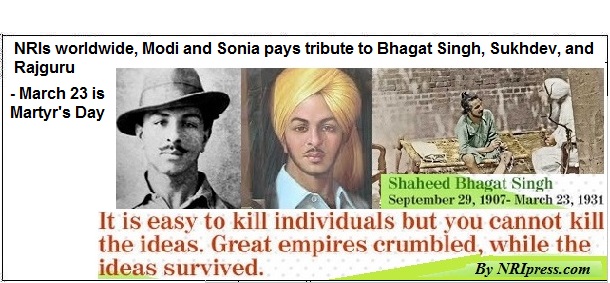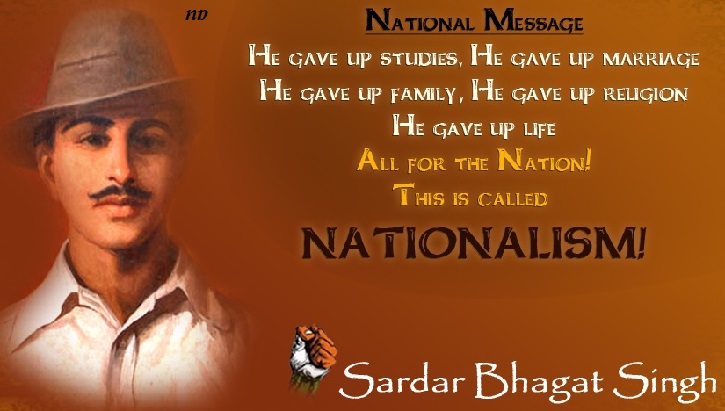 |
March 23 is Martyr's Day
NRIs worldwide, Modi and Sonia pay tribute to Bhagat Singh, Sukhdev, and Rajguru

Los Angeles, March 23, 2016
NRIpress.com/Ramesh/Gary Singh
Bhagat Singh, Sukhdev and Rajguru were hanged on March 23, 1931, at 7.30 p.m. in the Lahore jail. The anniversary of the deaths of Bhagat Singh, Sukhdev Thapar and Shivaram Rajguru on 23 March, 1931, is declared to be Martyr's Day
In India, there are several days declared as Martyrs' Day (at national level also known as Sarvodaya day and saheed din) it is named in the honour those who recognised as martyrs for the nation.
It was only on the 116th day of his fast, on October 5, 1929 that Bhagat Singh gave up his hunger strike (surpassing the 97 day world record for hunger strikes which was set by an Irish revolutionary). During this hunger strike that lasted 116 days and ended with the British succumbing to his wishes.
NRIs worldwide paid tribute to freedom fighters Bhagat Singh, Sukhdev and Rajguru on their martyrdom day.
Prime Minister Narendra Modi tweeted, " I bow to Bhagat Singh, Rajguru and Sukhdev on their martyrdom day and salute their indomitable valour and patriotism that inspires generations. In the prime of their youth, these 3 brave men sacrificed their lives so that generations after them can breathe the air of freedom."
Sonia Gandhi, Congress president paid tribute to freedom fighters Bhagat Singh, Sukhdev and Rajguru on their martyrdom day and said, "Three inspire every Indian -The heroism of deeds and clarity of thoughts displayed by these martyrs resonate in and inspire the minds of every Indian.”

Bhagat Singh
March 23, was declared as the martyrs day in India to remember the sacrifice and pay homage to the Bhagat Singh, Shivaram Rajguru and Sukhdev Thapar. Bhagat Singh, Shivaram Rajguru and Sukhdev Thapar who were fought for India against the British rule for independence.
Bhagat Singh was born on 28th of September in 1907 in the Lyallpur, Punjab in the Sikh family. His father was the member of an organization called Ghadar Party working for the independence of India. Bhagat Singh together with his companions Rajguru, Azad, Sukhdev and Jai Gopal fought for the assassination of Lala Lajpat Rai. The daring adventures of Bhagat Singh have become a great inspiration for the youngsters of today.
On April 8, 1929, he together with his companions threw bombs over the Central Legislative Assembly reading slogan “Inquilab Zindabad”. They charged with the murder and hanged at 7.30 pm in the Lahore jail on 23th of March in the year 1931. Their body was cremated at the banks of the Sutlej River. Now a day, a big Shaheedi Mela (Martyrdom fair) is held in the birthplace Ferozepur, at the National Martyrs Memorial in the Hussainiwala (Indo-Pak border).
- He lived only for 24 years but within this short span of time, he was able to make an everlasting impact on millions of millions of Indians.
- When Bhagat Singh was 12 years old, he visited the site of Jallianwala Bagh massacre where thousands of unarmed innocent people were killed which marked an impact of British cruelty on Indians on his mind.
- He had devoted his entire life for the cause of nation and that is why he was reluctant to get married. In fact he left the home to avoid marriage and wrote a letter in which he had quoted.
My life has been dedicated to the noblest cause, that of the freedom of the country. Therefore, there is no rest or worldly desire that can lure me now.
- In 1928, Simon Commission was set up by British but it did not have any Indian members. So there was a huge protest across the country. Lala Lajpat Rai led a march in protest against the Commission. Police attempts to disperse the large crowd resulted in violence. The superintendent of police, James A. Scott, ordered the police to lathi charge the protesters and personally assaulted Rai, who was injured. Rai died of a heart attatck on 17 November 1928. In a way to take revenge of his death, Singh conspired with revolutionaries like Shivaram Rajguru, Sukhdev Thapar and Chandrashekhar Azad to kill Scott. However, in a case of mistaken identity, the plotters shot John P. Saunders, an Assistant Superintendent of Police, as he was leaving the District Police Headquarters in Lahore on 17 December 1928.
- Bhagat Singh is most popularly known for his involvement in bomb explosion in Central Legislative Assembly on April 8, 1929. He along with his revolutionary friend Batukeshwar Dutt accompanied the explosion. They were present their only after the bomb blast and shouted the slogan “Inquilab Zindabad” and were arrested. Their intention was not to kill but to make their voice audible to British government as in the words of Bhagat Singh –
- ” If the deaf are to hear the sound has to be very loud”.
- The execution started and based on the investigation Sukhdev, Bhagat Singh and Rajaguru were found guilty of Saunders murder, Assembly bombing and bomb manufacture and were put in jail. The discrimination between European and Indian prisoners in all areas in jail lead to infinite hunger strike started by Bhagat Singh and his followers in jail in order to protest. The Britishers used all the ticks and tricks including force-feeding and other tortures but were unable to put single drop of water in their mouth. The fast lasted for 116 days until it broke.
- On 7 October 1930, the tribunal delivered its 300-page judgement based on all the evidence and concluded that participation of Singh, Sukhdev and Rajguru was proved beyond reasonable doubt in Saunders’ murder. They were sentenced to death by hanging. The remaining twelve accused were all sentenced to rigorous life imprisonment.
- On 23rd March, 1931, Sukhdev, Bhagat Singh and Rajaguru were hanged till death and became immortal in our heart. This day is celebrated as Shaheed Divasor Martyrs’ Day in India.
- Bhagat Singh was not only a revolutionary but he was a writer too. In his book “Why I am an atheist” he had thoroughly described the reason behind being an atheist. Please share one of the extract from that book which can be found on wikipedia page too…
As regard the origin of God, my thought is that man created God in his imagination when he realised his weaknesses, limitations and shortcomings. In this way he got the courage to face all the trying circumstances and to meet all dangers that might occur in his life and also to restrain his outbursts in prosperity and affluence. God, with his whimsical laws and parental generosity was painted with variegated colours of imagination. He was used as a deterrent factor when his fury and his laws were repeatedly propagated so that man might not become a danger to society. He was the cry of the distressed soul for he was believed to stand as father and mother, sister and brother, brother and friend when in time of distress a man was left alone and helpless. He was Almighty and could do anything. The idea of God is helpful to a man in distress.
- - - - - - - - - - - - - - - - - - - - - - - - - - - - - - - - - - - -
Bhagat Singh's book 'Why I am an atheist' still inspires young generation (March 23 is Martyr's Day)
By Mudita Girotra
New Delhi, March 23, 2016: At a time of upsurge in religious symbolism in the country, is Bhagat Singh's stand on atheism relevant? It would seem so, if one goes by the interest shown in his essay: "Why I am an atheist".
He wrote the essay in 1930 in Lahore central jail as a reply to a religious man who accused Bhagat Singh of becoming an atheist because of his vanity.
The essay was first published in 1934 and is said to be a tremendous read among the young generation.
"A large number of college students buy this book, not just because it is cheap and costs just Rs.35 but also because students show a lot of interest in Bhagat Singh," said a sales executive of Jain Book Depot who did not want to be named.
"It is not vanity that has actuated me to adopt the doctrines of atheism. I am neither a rival nor an incarnation, nor the Supreme Being Himself... By the end of 1926 I had been convinced as to the baselessness of the theory of existence of an almighty supreme being who created, guided and controlled the universe," said Bhagat Singh in his essay.
According to Chaman Lal, a retired professor of Jawaharlal Nehru University, who has written 11 books on the martyr, "there is tremendous interest among youngsters, scholars as well as seniors in Bhagat Singh,"
He said that because of the current debate on nationalism, the interest in Bhagat Singh and his ideology had increasing across the nation.
Martyr's Day, he said, is celebrated in the memory of all the revolutionaries who sacrificed their lives during the freedom struggle but "people are greatly affected by Bhagat Singh's personality."
The professor described many situations where a large number of people have carried out torchlight marches in honour of Bhagat Singh, who was hanged in Lahore jail on March 23, 1931 for his role in the assassination of John Saunders, a British police officer.
Bhagat Singh and his associates held Saunders responsible for the death of Lala Lajpat Rai, a leading luminary of the freedom movement.
"On Bhagat Singh's 100th birth anniversary in 2007, more than 10,000 people marched on the roads of Thanjavur town in Tamil Nadu to pay tribute to the martyr," Chaman Lal said.
"On Tuesday, more than a hundred students of Dr. Babasaheb Ambedkar Marathwada University took out a torchlight march in the honour of Bhagat Singh in Aurangabad," he added.
Chaman Lal, who has delivered more than hundred lectures on Bhagat Singh, not just in India but also in Canada, Mauritius and the US, among other nations said people abroad were highly influenced by Bhagat Singh's qualities as a political thinker.
"Indians celebrate him more because of his contribution to the freedom movement," he said.
According to Cheshtha Rajora, a Marxist thinker who's pursuing her masters in English literature from Delhi University, the right-wing ideologues who had appropriated Bhagat Singh would be shoced to know "whom they are dealing with."
Bhagat Singh, she said, had read all of Marx, Rosa Luxembourgh and Thomas Carlyle on the French revolution, as also other great tomes, by the time he was 22.
When I read "Why I am an atheist", I was surprised to find such a lucid explanation and potential in a young man of my age," said Rajora.
Many a young would probably have the same reaction.
(Mudita Girotra can be contacted at mudita.g@ians.in)
XXXXXXXXXXXXXXXXXXXXXXXXXXXXXXXXXXXXXXXXXXXXXXXXXXXXXXXXXXXXXXXXX
Bhagat singh's sister passes away in canada
Toronto Sep. 29, 2014
Chandigarh: Parkash Kaur, the younger sister of revolutionary and freedom fighter Bhagat Singh, has died in Canada, a family member said here Monday.
Kaur, 96, was the only surviving member of the martyr's immediate family. She was living in Toronto.
Her son-in-law Harbhajan Dingh Dhatt, who lives near Hoshiarpur in Punjab, said Kaur passed away late Sunday.
Kaur, in recent years, had pursued the case of the killing of Kuljit Singh Dhatt, brother of her son-in-law, by Punjab Police in a staged shootout. The police officers involved were, earlier this year, convicted by a court.
Bhagat Singh has been one of the most influential revolutionaries in the Indian independence movement against the British rule.
He was awarded capital punishment for killing a British police officer in Lahore in 1928. He was hanged to death in March 1931.
The 107th birth anniversary of Bhagat Singh was celebrated Sep 28.......IANS

|


